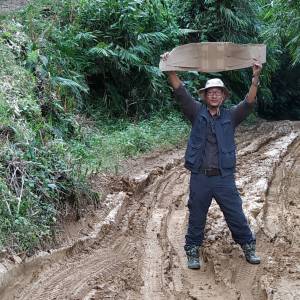Free As A Bird
Finally, the Chaak-kouba (grand feast) held without any mishap. Here is the bride with her pals post-feast.
Main stages of a typical wedding :
1. Chenba or Hainaba (Engagement or elope)
2. Haidokpa (announcement of the elope to the girl's parents by the boy's elders, in case of elope)
3. Machin Hangba (Cross examination of the girl by her elders if the elope was against her will or not etc.)
4. Nupi Thillakpa (Returning of the girl by the boy's elders to her home officially)
5. Warepnaba (both families meet to decide about the marriage and fixed its date)
6. Waroipot (the boy's family pays tribute to the girl's family to mark the decisive pact to hold the marriage on the scheduled time)
7. Heijingpot (the boy's family pays tribute with seasonal exotic fruits in combination with sweets and special items of food)
8. Bor Barton (official invitation of the groom to the upcoming wedding by the bride's family)
9. Awoonpot Thinba (sending of all the essential items required to run a new household to the groom's residence by the bride's family)
10. Cheng Heiba (filling in the coffer with rice by both the mothers of the bride and groom in their respective residence)
11. Pham Thaba (readying the bedclothes, pillows, mosquito nets etc. by the bride's party in the groom's residence)
12. Lei Lengba (making of the two Kundo garlands by the bride's own hands in the morning of the same day of the wedding)
13. Marriage
(i) Bor Jatra (the groom coming to the bride's residence where the wedding is normally held)
(ii) Mei Okpa (welcoming the groom with fires and essence)
(iii) Nga Thaba (releasing two fishes representing the bride and the groom respectively in the waters to see signs of their future)
(iv) Keinya Dan (main ceremony of handing over the bride to the groom by the bride's officially designated guardian)
(v) Punba (matrimonial tying of both the hands of the bride and the groom by the bride's mother or sister etc.)
(vi) Dan Thadaba (giving tribute to the couple by all family and friends and relatives)
(vii) Lei Koiba (the bridge circling the groom seven times showering him with flowers)
(viii) Lei Hukpa (garlanding the groom by the bride with both the Kundo garlands; and the groom garlanding her from one of the Kundo garlands)
(ix) Kangsubi Lannaba (Exchange of 'Kangsubi' an exquisite snack between the bride and the groom)
(x) Nupi Thillakpa (final farewel to the bride's family and coming to the groom's residence)
(xi) Mei Okpa (receiving the bride at the groom's place with fire and essence)
(xii) Pham Nanba (final conceding blessings given by the hands of the brother of the bride's mother on the newly set beds)
(xiii) Kwa Lannaba (final exchanging of betel between the two families)
(xiv) Bidding Farewell to the bride by her family and friends.
14. Nongngaanba (the day after marriage - the bride's party visits the grooms residence, the next day for matters obvious)
15. Phiruk Nungshang Kaiba Part -I :(the fourth day after marriage - the groom's party visits the bride's residence in the morning to inspect one special 'Phiruk' container containing rice, tobacco, ginger etc. to check for life i.e. any kinds of insects like ants, spiders etc.)
Part - II: In the afternoon, the bride's party in turn visits the groom's place to open all almirahs, boxes which were locked since wedding day to inspect for signs of life and vice versa)
16. Mapaam Chak-kouba (grand feast held in honour of the bride, groom, all family & friends and relatives who have taken part in the long process of the matrimony).
END.
Whew.
- 3
- 0
- Nikon D700
- f/7.1
- 52mm
- 200

Comments
Sign in or get an account to comment.


